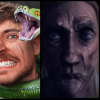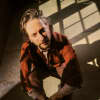In New York, The Kitchen’s stately black box theater was filled to capacity on Friday and Saturday for the first installment of Synth Nights, an electronic music series based on the idea of bringing together prominent musicians from different eras and areas of the genre. Curated by composer Nick Hallett, opening weekend featured Oneohtrix Point Never and decades-spanning electronic improv collective Musica Elettronica Viva, a pairing destined to remind us that while the storied performing arts space may be a bit late in paying lip service to contemporary synth-based music, its patronage of the form dates back to the early ‘70s. Themed loosely around the sample, both Synth Nights featured hearty amount of industrial groans and disembodied speech, and felt a bit like a performative illustration of what John Cage had in mind when he wrote, in his 1937 lecture The Future Of Music: Credo, that “wherever we are, what we hear is mostly noise. When we ignore it, it disturbs us. When we listen to it, we find it fascinating.”
On Friday, Oneohtrix Point Never’s Dan Lopatin took the floor with San Franciso video artist Nate Boyce, booting up for a continuous performance that would combine three audio-visual improvisations they showed at MoMA last year: the architecturally themed Reliquary House, Midday (on artist David Smith), and The Letter (on Anthony Caro). Clicking away on matching laptops, they let loose with a flickering medley of found sounds and video collage, the latter tending toward garish juxtapositions of two-dimensional found images and three-dimensional digital renderings. Snippets of OPN’s 2011 Replica LP mingled with seat-vibrating drones and grainy muzak jingles, more fodder in the whirlwind than points of interest in themselves. Depending on your mood, this ahistorical flux could feel either invigorating or panic-inducing, but more often that not, it dovetailed into the sort of undeniable groove that makes Lopatin a good crossover artist for pop-minded people. A bit harder to wrap one’s mind around was the duo’s interest in the sleek contours and streamlined simplicity of modernist art and architecture, perhaps best exemplified in The Letter, which combined some very academic-sounding text on the work of 1950s minimalist Anthony Caro with an animation of one of the artist’s abstract metal sculptures. When sound and image alike got absorbed back into the general churn, it was hard not to think about how archaic that speech was in its assumption that a work of art could possibly be doing something wholly new. Still, we can't really flatter ourselves that ours is the only generation privy to the idea of welding new forms out pre-existing cultural objects, because even he made many of his modernist masterpieces out of found industrial materials.
Musica Elettronica Viva, who performed the following evening, have been operating within that understanding for nearly half a century. Formed in Rome around 1966, the group was one of the first new music collectives to combine traditional classical instrumentation with its synthetic mirror image in the Moog; in addition to making early use of the sample, they allegedly affixed contact mics to anything that made a sound, from rubber bands and bed springs to tin cans and vibrating sex toys. Greying and bespectacled, founding members Richard Teitelbaum and Alvin Curran sat down at opposite ends of the stage in front of nearly identical laptop-keyboard combos; Frederic Rzewiski took the grand piano at center, and the performance began with what felt like a conceptual “sampling” of John Cage’s 4’33”—at least in the sense that the inactivity went on long enough to make all the sniffles and coughs in the audience sound like they might be construed as part of the “performance.” More likely, it was meant to recalibrate our ears after coming in from the Chelsea streets, because the first sound they brought in—gauzy and high-pitched, and of unidentifiable but probably synthethic origin—would’ve barely been audible without it.
Where Oneohtrix and Boyce’s performance was discomfiting and strobing, MEV’s was measured and precise, weighing silence against sound. Curran and Rzewiski dueled neo-impressionistically, free-associating a piano duet that sounded tender even at its most dissonant moments, as Teitelbaum confounded this opposition between analog and digital by triggering his own piano recordings, crackling with the passage of time. Somehow, Kennedy speeches, a grinding chinese violin, Dada poetry, an auctioneer chant and the sounds of industrial production found their way into the mix too. But what was shocking was not how “random” all this sounded but how considered and musical it did, as though MEV were actively exposing the way different emotional tones can be created through adjustments in volume and speed, and how sometimes placing a drum beat under a motley combination of sounds can make the whole thing shift into focus. Much like Dan Lopatin’s performance, curiously, it seemed to stem from the realization that once we’ve accepted that any sound can be music, we’ve got to figure out what kind of music that realization can inspire us to make.


